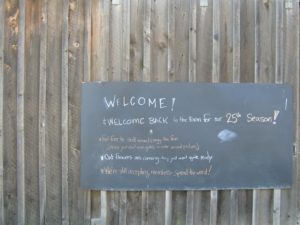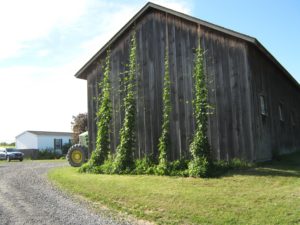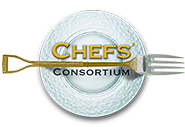Archive for June 2016
Tips For Storing The Bounty As 2016 CSA Farm Season Gets Underway

Sign welcoming CSA members, who pick up shares at Roxbury Farm, says to enjoy the farm but not to open gate and enter animal pastures.
Members of Community Supported Agriculture (CSA) farms are savoring the start of the 2016 farm season. Just Food, a praiseworthy organization based in New York City, each year connects nearly a quarter million New Yorkers with fresh food through its network of community food projects. And the organization offers special training for Gotham residents “to start and manage CSA projects in partnership with approximately 40 regional farms.” From one CSA in 1995, Just Food now assists more than 100 CSA programs.
Farms that work with Just Food include Roxbury Farm in Kinderhook (Columbia County, NY). This writer for the past few years has enjoyed a CSA share in Roxbury Farm, which also has weekly delivery of farm shares to the Capital Region of upstate New York, including a pick-up site in a nearby neighbor’s garage in my Albany neighborhood.
The 300-acre biodynamic Roxbury Farm is a granddaddy of CSAs in upstate, and the 2016 farm season is its 25th season of offering CSA shares. In addition to the weekly bounty, like many other CSAs, the farm suggests delicious recipes using the weekly food provided as well as updates about the farm and the current growing season in a weekly “Letter from a Farmer.” The first delivery of food this season included these handy storage tips from farmer Jody Bolluyt for the weekly bounty received:
Salad Mix: Wash your salad mix, then dry it in a salad spinner or with paper towels and store in a vented plastic bag in your fridge for over a week. If you store it wet, it won’t last for more than a few days.
Basil: Store in a glass of water on your kitchen counter like cut flowers and wash just before you use it.
Cilantro and parsley: Wash and dry your parsley and cilantro and then store in a vented plastic bag and wash just before you use them.
Bunches of greens (like kale): Dry the bunches with a paper towel, store in a vented plastic bag and wash just before you use them.
Zucchini and summer squash: The fridge is too cold for them so store them in a cool place in your kitchen and wash just before you use them.
Radishes: Blot the tops dry with a paper towel and store in a vented plastic bag in your fridge.
Turnips: You can eat the greens or treat them like radish tops and store in a vented plastic bag in your fridge.
Scallions: Store in a vented plastic bag in the fridge. Wash and trim just before you use them
Kohlrabi: Separate the leaves from the bulb and the bulb can be stored in your crisper drawer in your fridge. Peel the bulb before you eat it. You can also eat the leaves, similar to kale, but a bit tougher.
To be a part of a CSA farm means sharing in the life of a community that knows the farmers who grow its food, how it’s grown, and the specific spot on our planet where its food comes from. Each CSA is unique and offers special connections for members: from opportunities to enjoy a stroll on the farm and a weekly Letter From The Farmer, such as offered to its members by Roxbury Farm, to foraging classes and a solstice gathering on the longest day of the year offered to CSA members by Co-op 518 (a CSA farm in Princeton, New Jersey) or the special commitment and relationship between members of a full-diet, year-round CSA like Essex Farm (Essex, NY) and the on-going communications from hardworking, plus literary, farmer Kristen Kimball, author of The Dirty Life, A Memoir of Farming, Food, and Love, whose poetic and insightful Essex Farm Notes to her farm’s CSA members make for real awareness of the changing seasons.
Directories of CSAs throughout the United States and Canada are included on this website. And there’s still time to participate. Very likely, a slight reduction of the seasonal cost, typically $450-$700, would be offered for a late start of membership if shares are still available.
(Frank Barrie, 6/14/16)
College Art Majors Hit The Mark: Fat, Sugar, Salt & Marketing

Allison Borek’s watercolor on paper of a human heart inspired by cyclamen persicum
In late May and early June, the art departments of many, if not all, colleges bring attention to the creative energies of their graduating seniors, who have studied art and design. Here in the Capital Region of upstate New York, it’s an enjoyable experience to visit the student art exhibits mounted by colleges in the region at the end of the academic year.
This spring the creativity of two young artists on display at the Twelfth Annual Bachelor of Fine Arts Exhibition (May 6th-June 18th, 2016) at the Opalka Gallery located at Sage College of Albany (part of The Sage Colleges, which also includes the women’s college Russell Sage College in Troy, NY) deserves special recognition. This exhibition included work from “fine art, photography, interior design and graphic + media design students.”
Meradith Kill and Anne Marie Dolfi, both graphic and media design students and graduates of Sage College of Albany this year, have created insightful, yet playful, designs for edible food-like substances (thank you, Michael Pollan for the terminology) that powerfully critique the ability of marketers and promoters to sell products to consumers irregardless of nutritional and health concerns.
Meradith Kill’s Packaging Parody: Cereal Series uses artful packaging design to create colorful boxes of cereal that could be lining the shelves of conventional American supermarkets. But when examined closely, the artist’s packaging parody makes the viewer think deeply about the heavy-handed marketing of conventional breakfast cereals. If the colorful boxes are not viewed closely, very tempting to rip one open, dump the contents in a bowl and pour on the milk. But a close look reveals the General Kills Chocolax, SUBSTI FRUIT and Chemical Crunch cereals are best avoided. (Click on the photo to enlarge the image, and take a good look!)
Similarly, Annemarie Dolfi’s DO-NOTS conjures up a playful vocabulary for a sugary product that has special and widespread appeal for American consumers. Her tagline, “A Grab N’Go Breakfast With No Nutritional Value” pins the tail on the donkey. A close Where’s Waldo type of look at Dolfi’s creation reveals an ant, shaped like the devil, crawling over a pink DO-NOT. (Again, click on the photo to enlarge the image to see the details.) Humorous. But this send-up of the sophisticated marketing of children’s cereal and fast food doughnuts is a serious subject. Katie Couric’s Fed Up showed the public how very serious.
Also in the Capital Region, the Senior Art Exhibit (May 23rd-June 12th, 2016) presented by the Department of Visual Arts of Union College (Schenectady, NY) in the Mandeville Gallery, located in the college’s awesome 16-sided Victorian Nott Memorial, includes the work of a young artist, Allison Borek, who can be rightfully described as a very deep thinker.
Her artistic achievement entitled {Organ}ics consists of a series of watercolors on paper that complement sculptures of human organs she created using plants and flowers on foam-core board. The paintings have fine details and their creativity build on conventional medical illustrations. Her watercolor of the human heart inspired by cyclamen persicum is mesmerizing.
By her art, Ms. Borek shows that plants and human anatomy are “equally sophisticated in structure” in the artist’s words. She also offered these enlightening words to describe her artistic accomplishment: “Every single carbon atom that makes up the human body was at one time fixed in a plant during photosynthesis.” Indeed, that is an idea for anyone who cares about the future of our planet to mull over.
If readers are similarly fortunate to live near colleges and universities, it’s highly recommended to check to see if similar exhibits of art created by graduating students are on display to the public. This writer is looking forward to the Best of SUNY Student Art Exhibition 2016 (June 4, 2016 to October 23, 2016) opening later this week at the New York State Museum in Albany, NY. The works on exhibit were selected by a panel of jurors and represent “the wide range of media being studied by art students within SUNY and cover the traditional areas of drawing, painting, printmaking, ceramics, and sculpture, as well as digital imaging, photography, and mixed media installations.” This annual event, begun in 2002, recognizes the creativity of art students throughout the SUNY system of nearly 500,000 students enrolled in 64 campuses across New York State.
(Frank W Barrie, 6/2/16)












